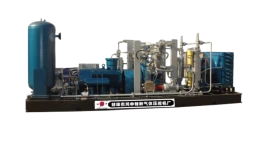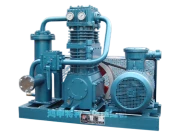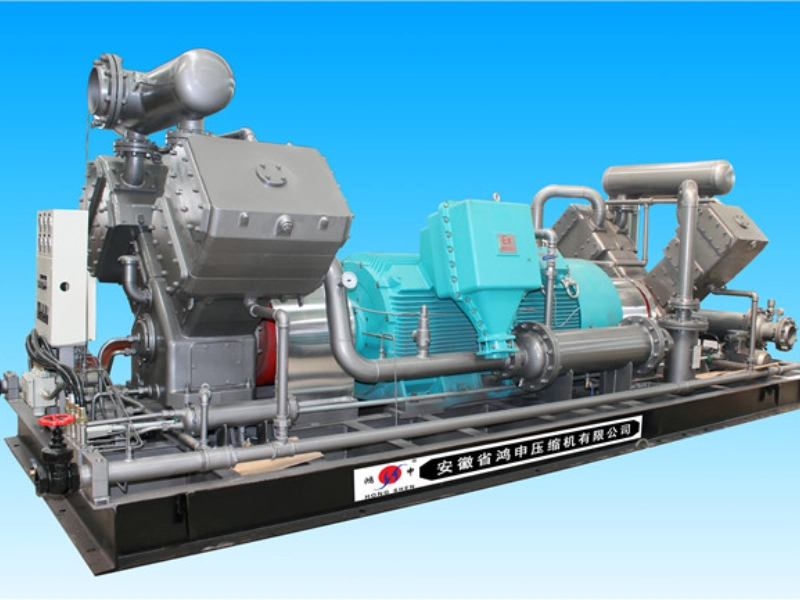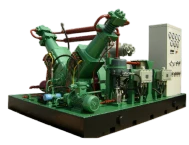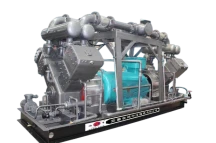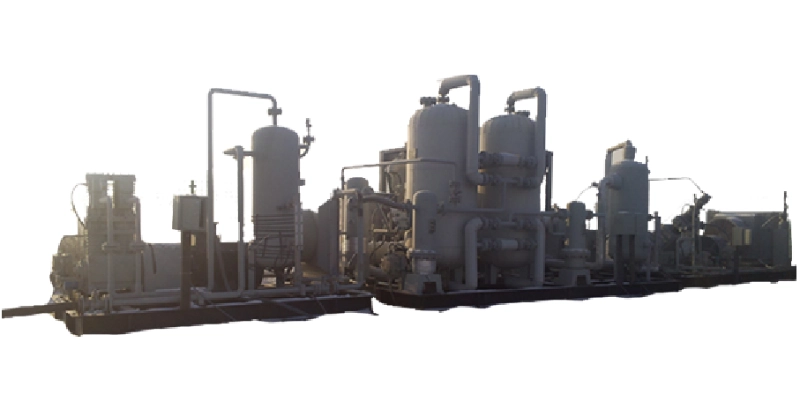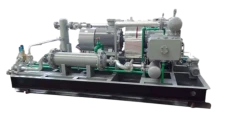Compressed Natural Gas (CNG) systems are technologies used for storing and transporting natural gas, primarily by compressing the gas to reduce its volume, making it easier to store and transport in high-pressure containers. CNG, as an alternative energy source, is widely used in fields such as automotive fuel and energy supply.
1. Basic Principles and Process:
The working principle of a compressed natural gas system is based on gas compression and high-pressure storage technology. Natural gas is a low-density gas, and under normal temperature and pressure, it has a large volume, making it difficult to transport or store. By compressing the gas in a compression unit to about 200-250 times the normal atmospheric pressure, its volume is significantly reduced, making it more convenient to store and transport.
The compression process mainly includes the following steps:
- Natural Gas Collection: The natural gas is collected from gas fields or other sources, such as the urban gas pipeline network.
- Compression Process: High-efficiency compressors are used to compress natural gas to a high-pressure state, typically 200-250 times normal atmospheric pressure. Common compression methods include single-stage compression and multi-stage compression.
- Storage and Transport: The compressed natural gas is stored in specially designed high-pressure gas cylinders, which can be used for transportation (e.g., by transport trucks) or distribution (e.g., at refueling stations). The storage tanks are usually made from steel or composite materials (such as carbon fiber and fiberglass-reinforced composites) to withstand high pressures.
- Gas Release and Use: When natural gas is needed, the pressure is gradually reduced to a usable level through pressure-reducing valves, providing the gas to internal combustion engines or other devices.
2. Components of a Compressed Natural Gas System:
A complete compressed natural gas system typically includes the following main components:
2.1 CNG Refueling Stations
CNG refueling stations are a key component, responsible for collecting natural gas from pipelines or gas sources and compressing it using compression equipment to a suitable pressure for distribution to users. The composition of a refueling station includes:
- Natural Gas Supply Pipeline: Delivers natural gas from the main gas network or a gas source to the refueling station.
- Compressor: Uses piston-type or screw-type compressors to compress the gas to high pressure. The efficiency, durability, and energy consumption of the compressors are crucial to the economic operation of the station.
- Storage Tanks: Store the compressed natural gas, typically high-pressure vessels that withstand pressures of 200-250 bar (20-25 MPa). The storage tanks must meet strict safety standards such as high-pressure resistance and seismic performance.
- Refueling Equipment: Composed of refueling guns, pipes, and valves, it provides safe and efficient refueling services. Refueling equipment typically features an automatic shut-off function to prevent overfilling.
2.2 Vehicle Refueling Systems
The refueling system in CNG vehicles includes:
- High-Pressure Gas Cylinders: The storage containers used in CNG vehicles to store compressed natural gas. These cylinders are typically made from composite materials (such as carbon fiber-reinforced plastics), which are lightweight and highly safe.
- Pressure Regulators and Valves: When gas is released from the storage cylinders in vehicles, the pressure is reduced by a regulator to a level suitable for the engine.
- Refueling Interface: The connection between the vehicle and the refueling station, typically equipped with an automatic docking system to ensure a safe and efficient refueling process.
2.3 Compressor Equipment
The compressor is the core equipment that compresses natural gas to high pressure. Compressors are typically selected based on the pressure requirements of the compression process. Common types of compressors include:
- Piston Compressors: These compressors compress gas through the reciprocating motion of pistons, suitable for applications with lower flow rates.
- Screw Compressors: These compressors use two intermeshing screws to compress gas, suitable for medium to high-flow and high-efficiency applications.
- Centrifugal Compressors: Primarily used in large natural gas compression stations, centrifugal compressors are highly efficient and suitable for large flow gas compression.
3. Advantages of Compressed Natural Gas Systems:
3.1 Environmental Benefits
- Lower Emissions: Compared to gasoline and diesel, CNG produces fewer pollutants when burned, especially in terms of carbon dioxide (CO2), nitrogen oxides (NOx), and particulate matter (PM). CNG emissions are typically 30%-40% lower than those of diesel and gasoline.
- Cleanliness: CNG produces almost no sulfur or smoke during combustion, reducing air pollution.
3.2 Economic Benefits
- Lower Energy Costs: Natural gas is generally cheaper than gasoline or diesel, and the energy costs for CNG vehicles are more stable, reducing the risk of price fluctuations seen in traditional fuels.
- Lower Vehicle Maintenance Costs: CNG vehicles typically have a longer engine lifespan and lower maintenance costs compared to traditional internal combustion engine vehicles.
3.3 Energy Security
- Abundant Domestic Resources: Natural gas is a relatively clean energy source and is abundant in many countries and regions. CNG helps reduce dependence on oil resources, enhancing energy supply diversity and security.
4. Challenges of Compressed Natural Gas Systems:
4.1 Safety Issues with High-Pressure Storage
Since CNG systems involve the storage and transport of high-pressure gases, it is essential to ensure that all equipment and storage cylinders meet strict safety standards to prevent leaks, explosions, or other accidents. High-pressure gas cylinders and refueling stations must comply with rigorous safety regulations.
4.2 Lower Energy Density
Despite the many advantages of CNG, its energy density is lower compared to gasoline and diesel. Even when stored under high pressure, CNG’s energy density remains lower than the same volume of gasoline or diesel, which generally results in shorter driving ranges for CNG vehicles.
4.3 Infrastructure Investment Costs
The widespread adoption of CNG requires significant investment in infrastructure, such as the construction of refueling stations and the expansion of gas networks. The high cost of these infrastructure developments may limit the rapid adoption of CNG systems in some regions.
Applications:
Compressed natural gas is widely used in the following fields:
- Transportation: CNG is commonly used in public transportation vehicles (such as buses and taxis) and freight vehicles, particularly for short-distance urban transportation.
- Industrial Applications: CNG is used as fuel in industrial heating furnaces, boilers, and power generation applications.
- Residential Energy: In some areas, CNG is also used for residential heating and cooking, providing a cleaner energy option for homes.
Compressed natural gas systems offer an economical and clean energy solution, particularly suitable for transportation and industrial applications. While there are some challenges, such as safety concerns with high-pressure storage and lower energy density, CNG is gaining increasing attention from governments and industries as an alternative energy source. With advancements in technology and infrastructure, CNG continues to grow in importance as a sustainable energy option.

